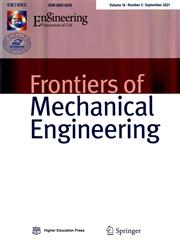用于航空发动机原位维修的索驱动连续机器人的综合动静力学建模和形态表征
IF 4
2区 工程技术
Q1 ENGINEERING, MECHANICAL
引用次数: 0
摘要
摘要原位维修对于提高航空发动机的工作效率和保证发动机的安全具有重要意义。具有双支点柔性机构的缆索驱动连续机器人(CDCR)具有柔性变形能力和有限空间可达性,是一种旨在促进航空发动机现场维修智能化和高效性发展的新型工具。该高保真模型描述了CDCR的运动和形态,为原位维修的精确操作和控制奠定了基础。然而,这个模型在以前的文献中没有得到很好的解决。在这项研究中,提出了一种综合考虑电缆孔摩擦、重力和有效载荷影响的通用动静力建模和形态表征方法,用于具有双轴柔性机构的CDCR。首先,通过结构优化和运动参数分析,提出了一种具有变摩擦系数和自适应摩擦方向准则的电缆孔摩擦模型;其次,考虑了电缆孔摩擦、全分量重力、挠曲引起的柔性关节重心偏移和有效载荷,推导出了一个综合的动静力模型,该模型能够准确表征CDCR的形态特征。最后,集成了一个紧凑的连续机器人系统,实验验证了所提出的动静力学模型和航空发动机原位维修的概念。结果表明,该模型能准确预测CDCR的形态,优于传统模型。紧凑的连续体机器人系统可以被认为是一种新的解决方案,以一种侵入式的方式执行航空发动机的原位维修任务。本文章由计算机程序翻译,如有差异,请以英文原文为准。
Comprehensive kinetostatic modeling and morphology characterization of cable-driven continuum robots for in-situ aero-engine maintenance
Abstract In-situ maintenance is of great significance for improving the efficiency and ensuring the safety of aeroengines. The cable-driven continuum robot (CDCR) with twin-pivot compliant mechanisms, which is enabled with flexible deformation capability and confined space accessibility, has emerged as a novel tool that aims to promote the development of intelligence and efficiency for in-situ aero-engine maintenance. The high-fidelity model that describes the kinematic and morphology of CDCR lays the foundation for the accurate operation and control for in-situ maintenance. However, this model was not well addressed in previous literature. In this study, a general kinetostatic modeling and morphology characterization methodology that comprehensively contains the effects of cable-hole friction, gravity, and payloads is proposed for the CDCR with twin-pivot compliant mechanisms. First, a novel cable-hole friction model with the variable friction coefficient and adaptive friction direction criterion is proposed through structure optimization and kinematic parameter analysis. Second, the cable-hole friction, all-component gravities, deflection-induced center-of-gravity shift of compliant joints, and payloads are all considered to deduce a comprehensive kinetostatic model enabled with the capacity of accurate morphology characterization for CDCR. Finally, a compact continuum robot system is integrated to experimentally validate the proposed kinetostatic model and the concept of in-situ aero-engine maintenance. Results indicate that the proposed model precisely predicts the morphology of CDCR and outperforms conventional models. The compact continuum robot system could be considered a novel solution to perform in-situ maintenance tasks of aero-engines in an invasive manner.
求助全文
通过发布文献求助,成功后即可免费获取论文全文。
去求助
来源期刊

Frontiers of Mechanical Engineering
Engineering-Mechanical Engineering
CiteScore
7.20
自引率
6.70%
发文量
731
期刊介绍:
Frontiers of Mechanical Engineering is an international peer-reviewed academic journal sponsored by the Ministry of Education of China. The journal seeks to provide a forum for a broad blend of high-quality academic papers in order to promote rapid communication and exchange between researchers, scientists, and engineers in the field of mechanical engineering. The journal publishes original research articles, review articles and feature articles.
 求助内容:
求助内容: 应助结果提醒方式:
应助结果提醒方式:


